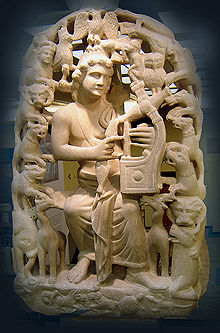Musical system of ancient greece
| Music of Greece | |
|---|---|
 |
|
| General topics | |
|
|
| Genres | |
| Specific forms | |
| Media and performance | |
| Music awards |
|
| Music charts | |
| Music festivals | |
| Music media |
|
| Nationalistic and patriotic songs | |
| National anthem | "Hymn to Liberty" |
| Regional music | |
| Related areas | Cyprus, Pontus, Constantinople, South Italy |
| Regional styles |
|
The musical system of ancient Greece evolved over a period of more than 500 years from simple scales of tetrachords, or divisions of the perfect fourth, to The Perfect Immutable System, encompassing a span of fifteen pitch keys (see tonoi below) (Chalmers 1993, chapt. 6, p. 99)
Any discussion of ancient Greek music, theoretical, philosophical or aesthetic, is fraught with two problems: there are few examples of written music, and there are many, sometimes fragmentary, theoretical and philosophical accounts. This article provides an overview that includes examples of different kinds of classification while also trying to show the broader form evolving from the simple tetrachord to system as a whole.
At about the turn of the 5th to 4th century BCE the tonal system, systema teleion, had been elaborated in its entirety. As an initial introduction to the principal names of the divisions of the system and the framing tetrachords, a depiction of notes and positional terms follows.
Greek theorists conceived of scales from higher pitch to lower (the opposite of modern practice), and the largest intervals were always at the top of the tetrachord, with the smallest at the bottom. The 'characteristic interval' of a tetrachord is the largest one (or the 'tone' in the case of the 'tense/hard diatonic' genus). The image shows the descending two octaves of tones with corresponding modern note symbols and ancient Greek vocal, and instrumental, note symbols in the central columns. The modern note names are merely there for an orientation as to the intervals. They do not correspond to ancient Greek pitches or note names. The section delimited by a blue brace is the range of the central octave. The range is approximately what we today depict as follows:
The Greek note symbols originate from the work of Pöhlmann (1970).
The Greater Perfect System (systêma teleion meizon) was composed of four stacked tetrachords called the (from bottom to top) Hypatôn, Mesôn, Diezeugmenôn and Hyperbolaiôn tetrachords (see the right hand side of the diagram). Each of these tetrachords contains the two fixed notes that bound it.
The octaves are each composed of two like tetrachords (1–1–½) connected by one common tone, the ''Synaphé. At the position of the Paramése, which should be the connecting (Synaphé) tone, the continuation of the system encounters a boundary (at b-flat, b). To retain the logic of the internal divisions of the tetrachords (see below for more detail) such that méson not consist of three whole tone steps (b-a-g-f), an interstitial note, the diázeuxis ('dividing') was introduced between Paramése and Mése. The tetrachord diezeugménon is the 'divided'. To bridge this inconsistency, the system allowed moving the Néte one step up permitting the construction of the synemmenón ('connecting') tetrachord (see the far left of the diagram).
...
Wikipedia
